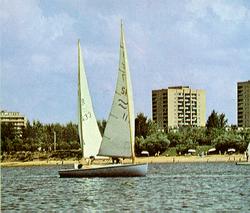 The small, pleasant city of Dubna on the bank of the Volga River is known as Naukograd, or Science City, and for good reason: it lends its name to element 105 of the periodic table, dubnium, and is home to the research institute where the five newest elements were discovered. The small, pleasant city of Dubna on the bank of the Volga River is known as Naukograd, or Science City, and for good reason: it lends its name to element 105 of the periodic table, dubnium, and is home to the research institute where the five newest elements were discovered.
Russian scientists at the Joint Institute for Nuclear Research, collaborating with a team of American researchers at a laboratory in California, are pushing the boundaries of the tangible world and adding tantalizing tidbits to the understanding of the origin of life`s chemical building blocks and how they behave.
In October, they announced the discovery of the heaviest element ever, 118, and there might be more elements beyond, potentially with applications as seemingly unthinkable as nuclear power once was.
"During the last 10, maybe more, years, it`s the most interesting problem for all nuclear physicists," said Mikhail Itkis, the research institute`s vice director. Itkis, a nuclear physicist himself, knows the atomic number of every element in Dmitri Mendeleev`s famous table and has a text on "exotic nuclei" on his bookshelf.
Technically, the new elements weren`t discovered so much as created. No element after 92, uranium, occurs naturally; they can only be synthesized in labs. And not many labs worldwide have the capacity to do work on super-heavy elements.
It is delicate, painstakingly slow and, often, fruitless. Ken Moody, a nuclear chemist at California`s Lawrence Livermore National Laboratory and the lead American researcher on the project, has compared the process to bowling: Inside a mammoth machine sometimes referred to as an atom-smasher, the scientists in Dubna essentially flung calcium atoms -- the bowling balls -- down a lane at incredibly high speeds toward californium atoms, the pins.
Over six months in 2005, they did this 10 billion billion times -- that`s a 10 with 18 zeroes. All of the shots ended up in the gutter -- except three. Three times, the calcium and californium stuck together, creating three atoms of the new element.
"When you get up into this part of the periodic table, it`s very difficult to make things," Nancy Stoyer, a nuclear chemist at Lawrence Livermore who worked on the research, said in an interview. "You tend to only make an atom at a time, especially when you have half-lives that are milliseconds."
Short half-lives -- the amount of time it takes for half of a quantity of an element to decay -- mean instability. Element 118, with a half-life of just under a millisecond, disappeared almost as soon as it was created. But its discovery could suggest the existence of heavier, more stable elements that belong to the long-sought "Island of Stability."
Science City by decree
Dubna, about 75 miles north of Moscow with a population of 70,000, is primarily known for the institute (though, largely surrounded by water, it`s also home to a well-regarded water skiing school and last year was the host of a leg of the international Water Ski World Cup). The municipal flag screams science: It depicts a gear, the curves of an oscilloscope -- an instrument that graphs electrical signals -- and two orbiting electrons. President Vladimir V. Putin officially decreed Dubna as Science City in 2001.
The institute`s Flyorov Laboratory of Nuclear Reactions, one of seven labs on the campus, is a long, white building among other buildings, behind a guarded gate. Nearby, the administrative offices sit on Joliot-Curie Street, named for the husband-and-wife team of Frederic Joliot and Irene Curie, who shared the 1935 Nobel Prize in chemistry for their synthesis of new radioactive elements.
The atom-smashing takes place in an decades-old particle accelerator called the U400 in a warehouse-like space with a high ceiling and a row of windows at the top. The device, known as a cyclotron, is a monster of blue-painted steel, gauges of all types and long tangles of wire; the top can be reached only by climbing a steep set of stairs. When the accelerator is working, an orange sign -- "Cyclotron in Use" -- flashes outside. A red and green traffic light indicates whether it`s safe to enter, given the radiation.
The work done here furthers scientists` understanding of the very nature of matter: how atoms stick, and stay, together.
"It`s pushing and trying to figure out how it all fits, how it all works, why are things the way they are," Stoyer said.
How element 118 could eventually be used is anyone`s presumption. The previous discovery of heavy elements led to a variety of applications: Nuclear weapons use 94, plutonium. Smoke detectors use 95, americium. An imaging technique known as neutron radiography uses 96, curium.
Discovered twice
Element 118 has actually been "discovered" twice. Scientists at another California lab, the Lawrence Berkeley National Laboratory, announced to great fanfare in 1999 that they had discovered it. "It`s a mistake," Itkis recalls telling colleagues at the time.
And it was. The researchers retracted their published findings in 2001 after one was found to have falsified some of the work.
The Dubna-Livermore team won`t get to name any of the five newly discovered elements just yet. The International Union of Pure and Applied Chemistry oversees the process, but an independent lab must first confirm the findings. The union then will solicit names from the scientists.
So far, the Russians have at least two possibilities in mind: flyorium, after the scientist for whom the laboratory is named, Georgy Flyorov; and moskovium, in honor of Moskovskaya oblast, the region in which it`s located. - By Erika Niedowski, Sun reporter.
sections: World News, Region News, Hi-Tech
areas: Central region
|